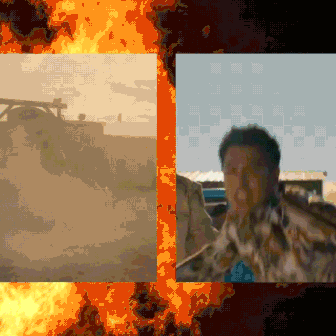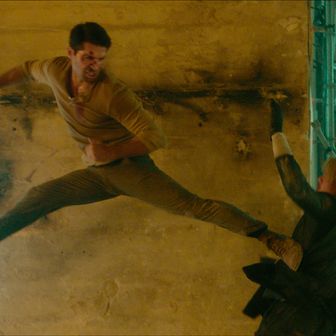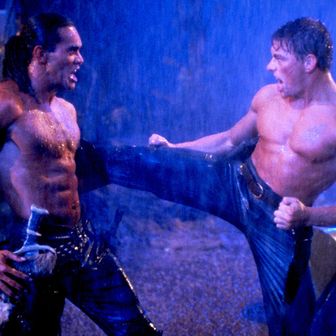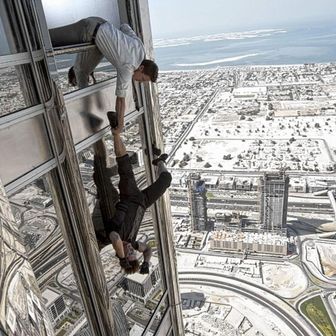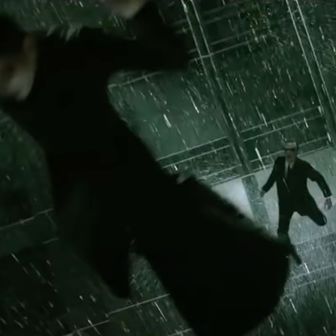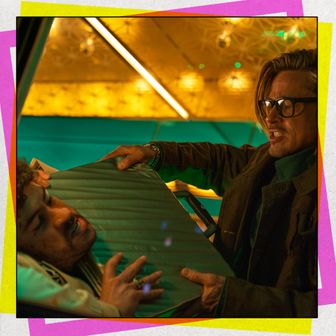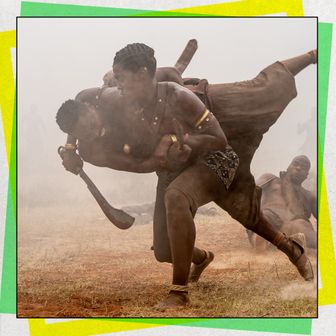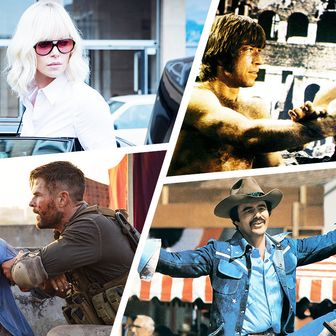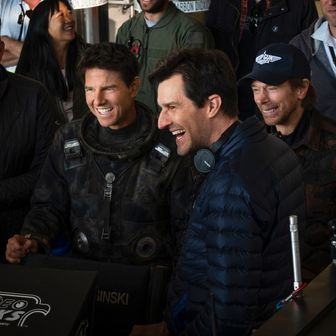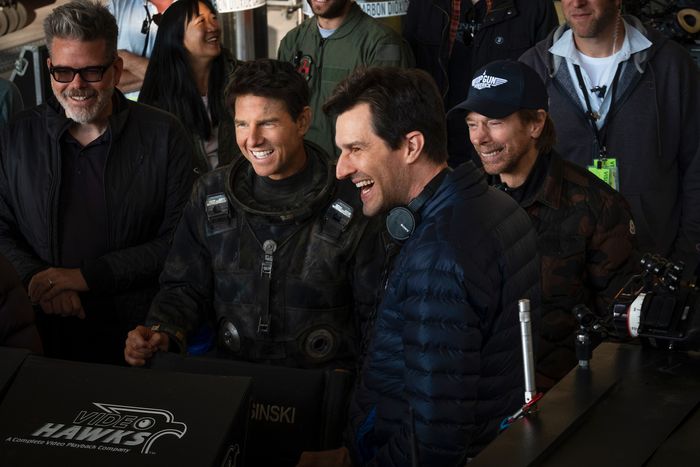
When I last spoke to Joseph Kosinski, Top Gun: Maverick was just hitting theaters. Critics were raving, and audiences were elated. Still, nothing could have prepared the director for what happened next. The months following Maverick’s release made it clear that the film was more than just a fun, summer action flick — it was a cultural phenomenon. Kosinski knew he was making something with genuine dramatic weight alongside spectacular action sequences. But he admits that he wasn’t prepared for Maverick’s long tail — the box-office records, top-ten lists, critics’ awards, Best Picture Oscar nomination. The movie has now also won three Vulture Stunt Awards for Best Action Film, Best Aerial Stunt, and Best Overall Stunt. Kosinski, who is currently in the midst of production on the racing drama F1, marvels at the fact that almost a year after Maverick came out — and four years after it was filmed — he’s still doing these interviews.
As soon as it opened, it became very clear that Maverick was more than just a fun summer movie. There were people crying in the theaters. People were going to see it over and over again. It won critics’ awards, made tons of top-ten lists, and is now nominated for a Best Picture Oscar. To what would you ascribe this success?
I still stand by the original intent of film, which was to tell an emotional, relatable story about a guy going through a rite of passage at a later point in his life. The first film, I always said, was a drama wrapped in an action film. And that’s why when I heard we’d won Best Action Film, Best Stunts, I thought, Would I ever describe it that way? Did I ever think of it as an action film when I was making it? I didn’t. The drama was always at the forefront. The execution of the flying sequences was in support of that.
Every action sequence, we’re always telling a story, pushing the narrative forward, learning something about the character’s state of mind. We tried to do that not only in every sequence but every shot of every sequence. So, sure, it’s the action that got people in to see it the first time, but it was the emotion that brought them back for viewings two, three, four. Some guy came up to me other night, said he had seen it 32 times! It’s the emotion that brings people back. And that’s, I think, the key to giant hits. I don’t know if you saw Avatar 2, but I felt like that with that film, the spectacle was one part of it, but there was a real emotional through line that got me. So emotion is key, but you need to make something that the audience knows they have to see on the big screen to get the full experience.
In terms of always keeping the drama and emotion at the forefront, what did it mean for how you filmed the action sequences?
We knew that the way to really make an action sequence work is if you’re invested in the characters in the middle of it. You had to care about not only Maverick and Rooster but feel like you were invested in the other characters as well. We knew we were building to this third-act sequence.
The wonderful thing that the first movie did was it told you that Top Gun is not afraid to kill a character you love, right? The first film killed Goose. So that was something we benefited from. We knew that if we could set this film up structurally and emotionally, so that going into that third act you think that either Maverick or Rooster is going to get killed on this mission, then we’ve done our job. If you go back through the film, you’ll see that every scene is pointing in that direction. It’s trying to set up that dramatic question right at the top of the third act, which is that someone’s going to die in this movie. It could be Maverick or Rooster, and we don’t know which one it’s going to be, but it’s going to be one or the other.
I’ve said this a lot: The casting is 80 percent of directing, and the bond our cast formed is so natural and real that you feel that. You care about Phoenix, Bob, Fanboy, and Payback in that Coffin Corner sequence, because even though it’s a Tom Cruise film, each of those actors has made an impression in their moments onscreen. Tom often talked about it as a sports-movie structure, and I think he’s right. That is probably the closest analog we had for how to construct the film.
I imagine that informs the way you put the actors in the cockpit and took them up in those planes. So much of the film happens in close-up. It happens in close-up when they’re on the ground, in more dramatic scenes, but then they go up in the planes and it’s still in close-up.
What you see those actors going through in a real plane I just don’t think you could fake. I don’t think the greatest actor in the world can really sell the idea of going 600 miles an hour and pulling seven Gs. That was why we went to all the extreme effort to try to shoot it that way. And that was above and beyond the call of duty for an actor. They all stepped up, and what they achieved is on film forever.
What was the toughest stunt you had to direct on this film?
I mean, the hardest one, which is one that you wouldn’t think, was actually the sailing sequence. Because there was so much out of our control. I had to shoot that scene three times in three different places before we got it. I shot it off the coast of Los Angeles — there was no wind. Then two weeks later, I shot it off the coast of San Diego — there was no wind. Then we took the whole scene and crew up to San Francisco — and the wind blew like hell. So what you’re seeing is Tom and Jennifer Connelly on a very, very fast carbon-fiber racing boat doing 20, 22 knots. We had an America’s Cup team stuffed into the hull of that thing in case anything went wrong. And Claudio Miranda, the cinematographer, and I are on a boat next to it with a Technocrane. I’m literally holding on to Claudio’s chair for dear life, trying to look at the monitor, and he’s operating the camera.
The logistics of being able to pull off a sailing sequence gave me so much more appreciation for … you remember that movie Wind with Matthew Modine and Jennifer Grey?
Oh yeah.
I watch that movie now and go, Holy shit, how did they do that? This is really, really difficult to pull off. So that was an unexpected challenge that was very different than the aerial stuff.
But from an aerial point of view, the third act was a monster of logistics, planning, storyboarding, and working in a naval low-level training range up in the Cascades. So that was an extremely complex sequence to figure out. Mav’s low-level, when he proves that the course can be run in two minutes and 15 seconds, was probably the most extreme thing we shot. Just watching that footage, you can see Tom looking directly into the sheer rock face next to him and seeing the shadow from his own jet about 15 feet away. That tells you how extreme the flying was for that sequence. That was probably the most dangerous thing we did.
What are your thoughts on an Oscar for stunts?
I think it would be great! If you look at the kind of stuff that’s being done today in various films, the level of skill, planning, and technical know-how to pull some of these things off is astonishing. Also, it would promote practical filmmaking. Because I think that the audience, when they know something was done for real and not on a computer, they appreciate it intellectually, but emotionally they also feel it.
I’ve talked to a few VFX artists, people who work with CGI, and they all seem very supportive of the idea of a stunts Oscar. Because they feel that when there are great stunts, the CGI itself looks better. Their work becomes easier.
Top Gun has a lot of visual-effects shots in support of live-action photography. So when you are looking at an F-14 flying in our film (or a Sukhoi Su-57), we didn’t have access to those airplanes. Those planes are being played by Navy F/A-18s reskinned digitally in a way that’s so real that you would never know. I think that’s a great example of using the strengths of practical photography, then an incredible VFX team using movie magic to turn it into something else. Our practical team worked with our digital team to create something that is just not possible otherwise.
Was there anything on Maverick that you felt you weren’t ready for?
I guess I was very lucky. My first film, Tron: Legacy, was a massive technical challenge, and we were innovating on a lot of different levels. I had done a movie with Tom Cruise before, so I think that maybe what I wasn’t ready for was more of the aftermath of the movie coming out. I haven’t had that on a film I’ve done before. I’ve certainly had people come up to me and — whether it’s Tron: Legacy, Oblivion, or Only the Brave — say that they appreciate the work. But this is a whole other level. This is a movie that was seen by everybody. And the whole awards-season marathon is something I hadn’t done before. So that I didn’t anticipate. Here we are. It’s, what, March now? And we’re still talking about it, and I’ve still got a couple more things to go to. So it has been quite a ride.
This interview has been edited and condensed.
More From This Series
- And the Winners of the 2025 Stunt Awards Are …
- The Third Annual Stunt Awards Are Here
- And the Winners of the 2024 Stunt Awards Are …


